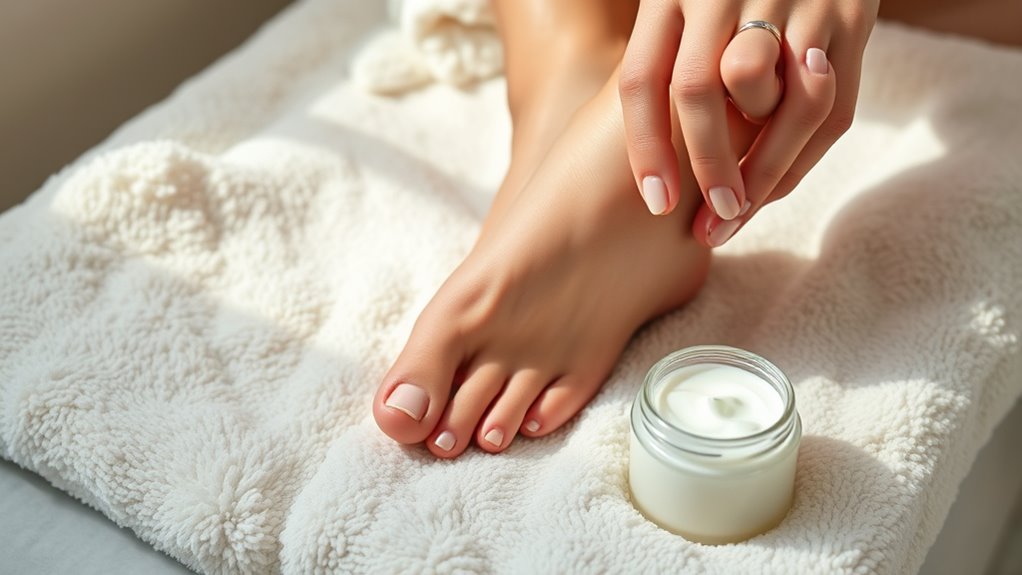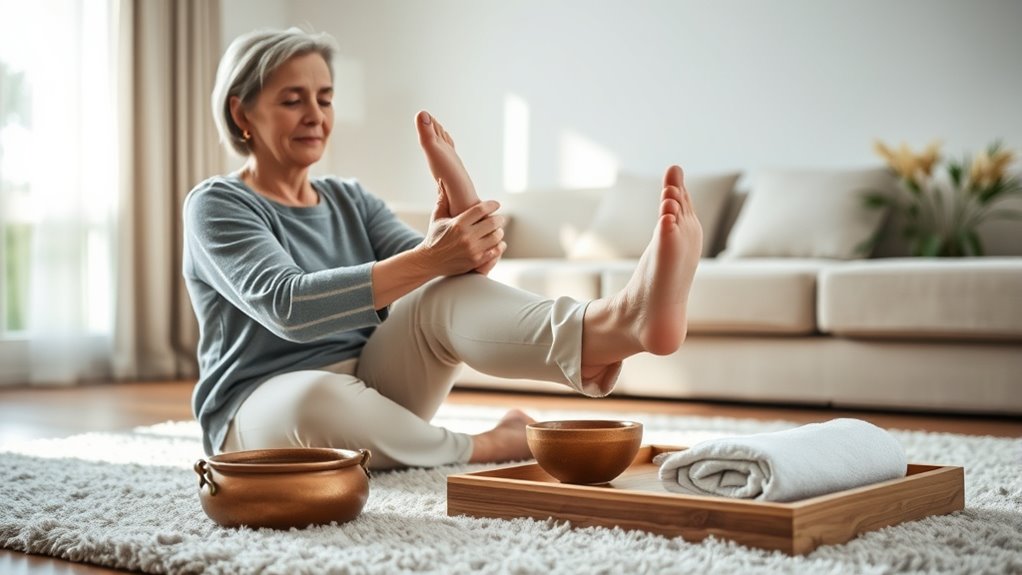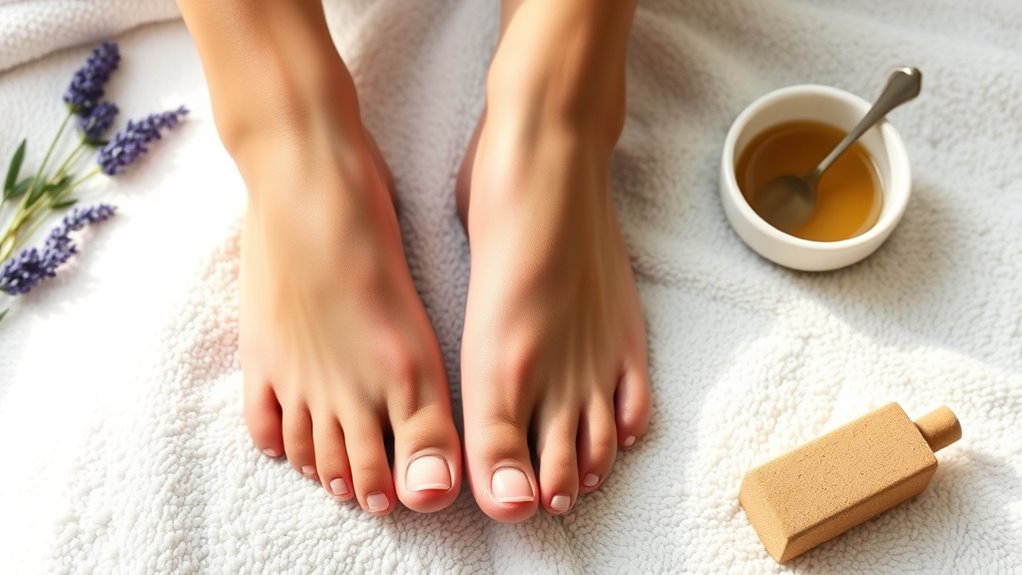To care for your feet after 40, focus on daily hygiene by washing and thoroughly drying them, using moisturizers to prevent cracks, and trimming nails properly. Wear supportive shoes with good arch support, avoid high heels, and incorporate foot exercises like stretching and strengthening to boost flexibility. Watch for persistent pain or deformities, and see a podiatrist when needed. Staying consistent with these habits helps maintain comfort and mobility—keep going to discover more tips!
Key Takeaways
- Maintain daily foot hygiene by washing, drying thoroughly, and moisturizing to prevent dryness and infections.
- Choose supportive footwear with proper arch support and avoid high heels to reduce foot strain.
- Incorporate foot strengthening exercises and stretches to improve flexibility, stability, and reduce discomfort.
- Regularly inspect nails and skin, remove calluses, and address issues early to prevent infections and deformities.
- Seek professional foot care when experiencing persistent pain, deformities, or other concerning symptoms for proper diagnosis and treatment.
Understanding Age-Related Foot Changes

As you age, your feet naturally undergo changes that can affect their function and comfort. You might notice your nails becoming thicker or more brittle, which can lead to problems like ingrown nails or infections if not managed properly. Additionally, the arches of your feet may weaken over time, reducing natural arch support. This decline can cause discomfort, especially during prolonged standing or walking. Recognizing how your feet evolve with age helps you to maintain foot health by choosing footwear that offers adequate arch support and maintaining good nail health. Proper care now sets the foundation for healthier, more comfortable feet in the future. Incorporating appropriate footwear and considering the use of supportive insoles can further enhance foot comfort and stability as you age, especially since age-related foot changes can impact your overall mobility and well-being. Being aware of common foot problems that develop with age allows you to take preventative measures and seek timely treatment when needed.
Daily Foot Hygiene Practices

Maintaining good daily foot hygiene is essential for preventing infections and keeping your feet comfortable. Regular cleaning helps remove dirt and sweat, reducing the risk of fungal issues. To keep your feet healthy, follow these practices:
Good foot hygiene prevents infections and keeps your feet comfortable daily.
- Wash your feet daily with warm water and gentle soap.
- Dry thoroughly, especially between your toes.
- Use a pumice stone or foot file to gently remove calluses and prevent callus buildup.
- Trim your nails regularly with proper nail trimming techniques to avoid ingrown nails.
- Moisturize your feet to keep skin soft and prevent dryness or cracking.
- Being aware of trust issues can help you address underlying relationship concerns that may affect your emotional well-being.
- Incorporating AI-driven insights can assist in monitoring foot health and detecting potential problems early.
Choosing the Right Footwear

Choosing the right footwear is essential for supporting foot health and preventing discomfort or injury. Look for shoes that provide proper arch support and enough room for your toes to move freely. Incorporate orthotic insoles if you need extra cushioning or support, especially if you experience foot pain or flat arches. Heel cushions can also help absorb shock and reduce pressure on your heels, which is common with age. Avoid high heels or shoes with narrow toe boxes, as they can cause bunions or exacerbate existing issues. Instead, choose styles with a sturdy sole, good grip, and breathable materials. Proper footwear not only enhances comfort but also promotes overall foot health, reducing the risk of problems as you age. Additionally, selecting appropriate footwear materials can help prevent issues like blisters and fungal infections, promoting healthier feet. Using proper footwear care can extend the lifespan of your shoes and maintain their supportive qualities. Regularly inspecting your shoes for signs of wear and replacing them when necessary supports foot health maintenance and prevents discomfort. AI-powered virtual reality in e-learning can be used to educate women on proper footwear choices and foot care routines.
Effective Moisturizing and Skin Care

Have you noticed your skin becoming drier or more delicate with age? Proper moisturizing is essential to maintain soft, healthy feet. Use a rich, hydrating lotion daily, focusing on heels and soles to prevent callus buildup. Regular toenail trimming keeps nails neat and reduces the risk of infections. Incorporate gentle exfoliation to remove dead skin, helping moisturizers penetrate better. Avoid harsh soaps that strip moisture. For added protection, wear socks after applying lotion to lock in hydration. Remember, well-moisturized skin enhances callus prevention and reduces discomfort. Incorporating trusted skincare brands can ensure you’re using products formulated with quality ingredients. Additionally, understanding grocery savings strategies can help you allocate more resources toward self-care and foot health.
Incorporating Foot Exercises and Stretching

Adding foot exercises and stretching to your routine can improve flexibility and reduce pain. You’ll want to learn effective techniques that target key muscles and joints. Incorporate balancing poses to enhance stability and coordination in your foot health. Additionally, practicing AI safety measures can help ensure that health technologies used in your routine remain reliable and effective. Regularly performing foot strengthening exercises can further support overall foot stability and prevent injuries. Maintaining proper foot biomechanics is essential for long-term comfort and mobility. Let’s explore some beneficial exercises to keep your feet healthy and strong.
Effective Stretching Techniques
To maintain healthy feet over 40, incorporating effective stretching techniques is essential, especially since muscles and tendons tend to tighten with age. Proper stretching can help reduce arch pain and improve arch support, preventing discomfort and injury. Focus on gentle, targeted stretches to keep your feet flexible and strong. Regularly stretching your calves and Achilles tendons can also alleviate pressure on the arch. Be consistent, and avoid overstretching to prevent strain. These techniques enhance circulation and help maintain natural foot arches, reducing the risk of arch-related issues. Incorporating vetted foot care tools and routines can further support foot health and comfort. Additionally, understanding how AI in Education is transforming personalized learning can motivate you to stay engaged with your health routines.
- Roll a tennis ball under your foot to stretch and relax the arch
- Gently stretch your toes by pulling them back with your hand
- Sit and stretch your calves with straight legs and flexed feet
- Use a towel to stretch the bottom of your feet
- Perform toe scrunches to strengthen foot muscles
Beneficial Foot Exercises
Incorporating specific foot exercises alongside stretching can substantially enhance foot strength and flexibility as you age. These exercises help maintain proper arch support and improve overall foot health. Try toe curls, where you pick up small objects with your toes, and calf raises to strengthen your arches. Foot stretches like rolling a ball under your foot boost flexibility. Proper shoe fitting ensures your footwear provides adequate arch support, reducing strain. Celebrating the importance of preventive care can motivate consistent practice. Incorporating these exercises into your routine can enhance overall foot health and help prevent common issues such as plantar fasciitis or bunions. Regular practice is especially beneficial for aging feet, which tend to lose some natural flexibility and strength. Maintaining good foot hygiene is also essential to prevent infections and skin issues. Here’s a simple plan:
| Exercise | Technique | Benefits |
|---|---|---|
| Toe Curls | Pick up objects with toes | Improves toe strength |
| Calf Raises | Rise onto toes, hold, lower | Strengthens arches |
| Ball Roll | Roll a ball under foot | Enhances flexibility |
| Stretching | Foot stretches and massage | Prevents stiffness |
When to Seek Professional Foot Care

You should consider seeking professional foot care whenever you notice persistent pain, swelling, or discomfort that doesn’t improve with home treatments. Ignoring signs like these can lead to more serious issues, such as foot deformities or the need for surgical intervention. If you experience numbness, tingling, or difficulty walking, it’s time to see a specialist. Also, if you notice changes in the shape of your feet or persistent bunions, professional evaluation can prevent worsening. Addressing foot problems early can save you discomfort and costly treatments later. A podiatrist can diagnose underlying issues and recommend appropriate care, including custom orthotics or surgical options. Additionally, understanding Boho decor styles might inspire relaxing and comfortable environments that promote foot health by reducing stress on your feet. Incorporating proper footwear can also significantly decrease the risk of developing foot problems over time. Don’t delay seeking help if symptoms persist or worsen. Your feet’s health impacts your overall mobility and quality of life.
Frequently Asked Questions
How Often Should I Replace My Walking Shoes After 40?
You should replace your walking shoes when you notice signs of wear or after about 300 to 500 miles, as this impacts shoe longevity and walking shoe lifespan. Over 40, your feet may need extra support, so don’t wait too long — worn-out shoes can cause discomfort or injury. Check for thinning soles, compressed cushioning, or uneven wear, and replace them promptly to keep your steps comfortable and safe.
Are There Specific Supplements Beneficial for Foot Health Over 40?
Did you know that over 40, many women experience decreased bone density? Supplement benefits like calcium and vitamin D are essential for maintaining bone health and preventing osteoporosis. These supplements support strong bones and overall foot health. Incorporating them into your routine can make a significant difference, especially as you age. Always consult your healthcare provider to make certain you’re choosing the right supplements for your specific needs and health goals.
Can Foot Exercises Prevent Age-Related Bunions or Hammertoes?
You might wonder if foot exercises can prevent bunions or hammertoes as you age. While they won’t eliminate these conditions entirely, they do help improve foot flexibility and toe strengthening, which can slow their progression. Regularly stretching and strengthening your toes keeps muscles and ligaments more resilient, supporting proper toe alignment. So, staying consistent with foot exercises can be a helpful part of your foot health routine as you get older.
What Signs Indicate I Need Custom Orthotics?
If you notice arch pain or shoe discomfort that persists despite trying new shoes or stretches, it may be time to see a specialist. These signs suggest your feet might need custom orthotics to provide proper support and alignment. Don’t ignore ongoing discomfort, as it can lead to more serious issues. Consulting a podiatrist can help determine if custom orthotics are right for you, improving comfort and foot health.
How Does Menopause Affect Foot Health and Care Needs?
Menopause is like a shifting tide, stirring hormonal changes that can weaken your foot structure and cause circulation issues. You might notice increased dryness, aching, or swelling, making your feet feel less like sturdy foundations and more like delicate sculptures. To care for them, stay active, moisturize regularly, and wear supportive shoes. These small acts help your feet stay resilient amid the hormonal storm, keeping you steady on your journey.
Conclusion
By embracing these foot care routines, you’re nurturing your foundation, much like tending a sturdy oak that stands tall through seasons. As you walk through life’s journey, remember that healthy feet support every step, helping you move confidently and comfortably. With consistent care, you’ll keep your feet as resilient and graceful as a dancer’s final pose—ready to face each new day with strength and elegance.








